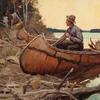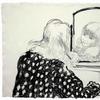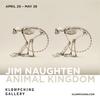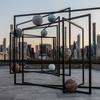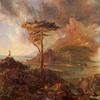'Warhol: Flowers in the Factory' Highlights Artist’s Surprising Interest in Exploring and Celebrating Nature
- SARASOTA, Florida
- /
- September 28, 2017
Selby Gardens in Sarasota, Florida, provides stunning botanical backdrop for focused exhibition examining Andy Warhol’s conservationist leanings
Andy Warhol remains one of the most influential, paradigm-shifting figures in contemporary art and culture, recognized as a pop artist, entrepreneur and innovator. Best known for his iconic Campbell’s Soup Cans, Coca-Cola bottles and portraits of the celebrities of his era, Warhol also had an unexpected artistic influence: the natural world. He had an abiding passion for preservation and often investigated nature through his work.
The artist’s particular interest in botanical life will be illustrated in the context of a world-renowned garden through a new colorful, focused exhibition next spring. Warhol: Flowers in the Factory will be on view Feb. 11-June 30, 2018, at Marie Selby Botanical Gardens in Sarasota, Florida.
The exhibition will feature four iconic Warhol silkscreens of hibiscus, on loan from Williams College Museum of Art, from the original series of 10 flower silkscreens produced in the mid-1960s. Archival photographs depicting the artist in nature will further reveal his fascination with the natural world. Two poinsettia prints by Warhol, originally created by the artist as holiday gifts for friends and on loan from Sarasota art patron Flora Major, will also be on view.
Dr. Carol Ockman, curator at large for Selby Gardens and the Robert Sterling Clark professor of Art History at Williams College, is curator of the exhibition. “Like the Campbell Soup cans and the portraits of superstars, the Flowers take a popular source, simplify it, then enlarge, print and repeat it mechanically,” Ockman said. “Equally fascinating is to think of the Flowers, and nature more broadly, as a regenerative tonic to the modern world at large.”
The grounds of the 15-acre Selby Gardens overlooking Sarasota Bay on the Gulf Coast of Florida will serve as a floral playground inspired by Warhol. Visitors will experience spectacular living displays both outdoors and in the glass house conservatory that capitalize on the artist's motifs of repetition, modular designs and juxtaposition. Explosions of color, texture and height will capture Warhol's energy in a tropical setting, encouraging a mutually enriched experience of art and nature.
“Warhol tested traditional boundaries between art and life, and thanks to his continuous curiosity, the natural world offered a still underappreciated influence on his career,” said Jennifer O. Rominiecki, president and CEO of Selby Gardens. “From his youth visiting botanical gardens in Pittsburgh to his conservation efforts in the Hamptons, Andy Warhol – like so many of us – was affected by nature. Now, 30 years after his death, our hope is for exhibition visitors to be inspired by the artist and the creative influence of the natural world in all our lives.”
Warhol: Flowers in the Factory is the second exhibition in the Jean and Alfred Goldstein Exhibition Series. The series combines nature and fine arts exhibitions, illuminating the connection between creativity, the natural world and artistic inspiration.
Accompanying performances celebrating the spirit of Warhol are planned throughout the exhibition, including programs by a few of Sarasota’s top cultural institutions: Perlman Music Program/Suncoast, Asolo Repertory Theatre, the Sarasota Ballet, the Sarasota Opera and the Sarasota Orchestra. A full schedule of events will be provided in late 2017 at www.selby.org.
Warhol: Flowers in the Factory has been made possible by generous support from Amicus Foundation, Betsy and Doug Elder, Gulf Coast Community Foundation, and State of Florida, Department of State, Division of Cultural Affairs and the Florida Council on Arts and Culture. Additional exhibition support has been provided by Gerri Aaron, Better-Gro, BMO Private Bank, The Doris M. Carter Family Foundation, Margot and Warren Coville, Drs. Andrew and Judith Economos, Gold Coast Eagle Distributing, Ernest R. Kretzmer, Flora Major, Katherine and Frank Martucci, and Williams Parker. Further support has been provided by Beverly and Bob Bartner, Linnie E. Dalbeck Memorial Foundation, Dart Foundation, Marcy and Michael Klein, and The Woman’s Exchange, with additional support from Teri A Hansen, Maria and Allen Heise/Aimee and Chris Cogan, and Charlotte and Charles Perret.
Since opening to the public in 1975, Selby Gardens has been internationally recognized for its focus as the only botanical garden in the world dedicated to the display of epiphytes. Its Museum of Botany & the Arts, housed in the historic 1934 Payne Mansion, has featured artwork celebrating the natural world since 1979, including the most recent 2017 exhibition, Marc Chagall, Flowers and the French Riviera: The Color of Dreams, which featured a masterwork by the artist.
About Marie Selby Botanical Gardens
Marie Selby Botanical Gardens is the only botanical garden in the world dedicated to the display and study of epiphytes – plants that grow on other plants without harming them – such as orchids, bromeliads, gesneriads and other tropical plants with a focus on botany, horticulture and environmental education. For more information, please visit www.selby.org.

